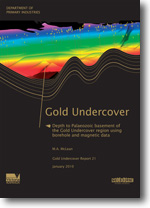GU Report 21 - Depth to Palaeozoic basement of the Gold Undercover region using borehole and magnetic data
 |
| |||||||||||||||
Product description:Abstract A new map depicting depth to Palaeozoic basement in the Murray Basin has been developed for the Gold Undercover region by integrating existing borehole data with new depth to magnetic source solutions derived using the AutoMagTM automatic analysis program, which is an extension of the ModelVision ProTM software package (Encom Ltd). Several depth to basement maps for the Murray Basin region have been developed in the past by a number of groups, but this new map utilises a quality controlled subset of the existing borehole dataset as well as the best available magnetic constraints. In investigations of this type it is typically assumed that borehole basement intersections are recorded correctly; however, this is not always the case. Material extracted from boreholes must be interpreted by the geologist or driller who logs the core. Regardless of the experience of the logger, different boreholes have been drilled for different purposes (e.g. for minerals, mineral sands or groundwater exploration). This leads to considerable inconsistency in how basement is interpreted. There are also large regions within the Gold Undercover area where no mineral exploration has taken place and where water bores do not penetrate basement, so there are considerable gaps in the borehole data. Therefore, depth to magnetic source data have been used to supplement borehole data and, where possible, to increase the overall confidence of the resultant basement map. In this study, depth to Palaeozoic basement from borehole data was determined from both mineral and groundwater bores. The borehole database was queried using the terms ‘bedrock’, ‘bed-rock’, ‘reef’, ‘bottom’, ‘granite’, ‘basement’, ‘shale’ and ‘schist’. The query was designed to capture the shallowest occurrence of these terms in each of the boreholes (if present). A total of 993 such points were identified within the Gold Undercover region. Mapping these points clearly illustrated an absence of data within the Mildura, Ouyen, Swan Hill, Horsham and St Arnaud map sheet areas. Magnetic depth-to-source estimates were calculated to increase the data density in this region and to provide quality control for the rest of the Gold Undercover region. AutoMagTM is a computer program that uses the Naudy technique to estimate depth to magnetic basement below superficial cover. High-quality, low-level aeromagnetic profiles over north-western Victoria were used for this project. Individual anomalies were isolated and identified, and the software was then used to compare the theoretical magnetic responses with the observed field and derive similarity coefficient traces along the line. Minima of similarity coefficient traces indicate good correlations of magnetic data with borehole data. A dyke model was first computed using AutoMagTM with a fairly high similarity coefficient cut-off. This resulted in a large number of solutions, which were filtered with the inbuilt AutoMagTM solutions filter. Negative susceptibilities and erroneous shallow dips were fi ltered out first. Then, a similarity coefficients filter was used to remove the less-likely solutions. This process was carried out for a series of depth slices to accommodate a wide spectrum of wavelengths. The AutoMagTM results were imported to GOCADTM (Paradigm Ltd) modelling software. Visualisation of the solutions in 3D provided an effective quality-control interface, which allowed spurious solutions to be identified and deleted. AutoMagTM solutions correlated well with the data extracted from the borehole database. Where AutoMagTM solutions conflicted with borehole data, the interpretation of borehole data was honoured. Once an acceptable set of solution data points was determined, a 3D surface was created through them using GOCAD. Points from this surface were subsequently gridded and displayed as a basement map. Download The report is supplied in (PDF) and the data file (ZIP). Bibliographic reference McLean, M.A., 2010. Depth to Palaeozoic basement of the Gold Undercover region from borehole and magnetic data. GeoScience Victoria Gold Undercover Report 21. Department of Primary Industries. Related products:
| ||||||||||||||||


